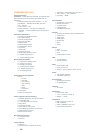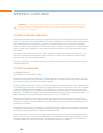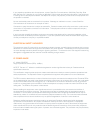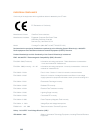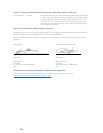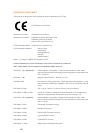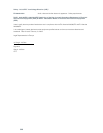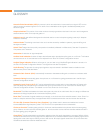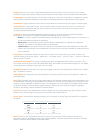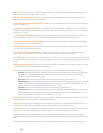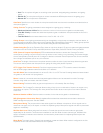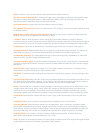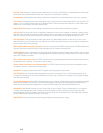314
Mute A condition in which an audio signal is attenuated below the audible threshold.
NLP (Non-Linear Processing) NLP increases the power of echo cancellation for difficult acoustical environments.
NLP has four settings: Soft (6dB), Medium (12dB), Aggressive (18dB), and Off. NLP settings are found in the
Channel Properties Configuration window for Mic Input channels.
Noise Cancellation A process which removes ambient noise from a signal.
NTP (Network Time Protocol) Part of the IP protocol suite, NTP is used for clock synchronization between devices
on IP-based networks.
NOM (Number of Open Mics)/Constant Gain Mode Adjusts the output level to maintain a specified gain level
based on the number of mics gated on and routed to an output.
I–R Buses These ten audio buses are used for routing microphone audio between Converge Pro devices.
Information about the number of gated microphones (NOM count) and other relevant information for the microphone
mixers are tracked for microphones routed to these buses. See also S-Z Buses and PA Adapt/AEC Reference Bus.
Off Attenuation The amount of level reduction a microphone is given when the microphone is not gated on.
PA Adaptive Mode PA Adaptive Mode allows you to specify an output as the ambient reference. This prevents an
audio signal from gating on microphones without interfering with speech from conference participants.
PA Adapt/AEC Reference This setting determines which output channel (typically a loudspeaker) is used as the
reference for AEC. See also PA Adaptive Mode and AEC.
Parametric Equalizer (PEQ) A multi-band variable equalizer with control of gain, center frequency, and bandwidth.
A properly configured PEQ enables Converge Pro devices to offset speaker anomalies and room acoustic imaging
deficiencies.
Phantom Power Power supplied by Converge Pro units to power condenser microphones. This feature can be
switched off for microphones that do not require phantom power.
Pink Noise An audio test signal containing all the frequencies in a given audio spectrum, with equal energy in each
octave.
Pre-AEC Cross Point Setting a Pre-AEC Cross Point in the Matrix bypasses the cross-pointed input audio from the
AEC (Acoustic Echo Cancellation) reference. This is primarily used for sound reinforcement applications to prevent
mic input channel audio from being degraded by AEC artifacts. See also AEC and Matrix Mixer.
Preset Presets provide the configuration flexibility needed to meet changing conference room requirements. These
changes include audio routing, gating, muting, levels, AEC referencing, and signal processing, as well as room
combining and room configuration. Presets allow you to make configuration changes instantaneously—without
interrupting or affecting any conferences in progress. There are 32 presets available on every Converge Pro device.
Preset Mask Defines whether a Preset executes on a low or high contact closure signal on the rear panel of the
unit.
Preset Mode Preset mode is used to create presets and is accessed from the Console toolbar.
Processing Blocks Processing blocks enable you to configure filters, delay, compression, and gain to create
precise audio configurations for any venue. A single input or group of inputs can be routed through a processing
block and then routed to an output or multiple outputs. There are four processing blocks available for the 840T and
eight for the 880 and 8I (A-D for 840T, A-H for 880 and 8I). See also Filters, Delay, Compression, and Matrix.
Q (Quality Factor). It is the ratio of the center frequency divided by the bandwidth. Q reflects an inverse
relationship to the bandwidth, and is adjustable from .02:1 to 40:1.
Ratio The amount of compression applied to the output signal compared with the input signal as the signal exceeds
the threshold level. See also Compressor, Compression, and Threshold.




